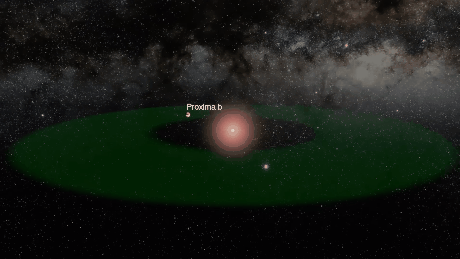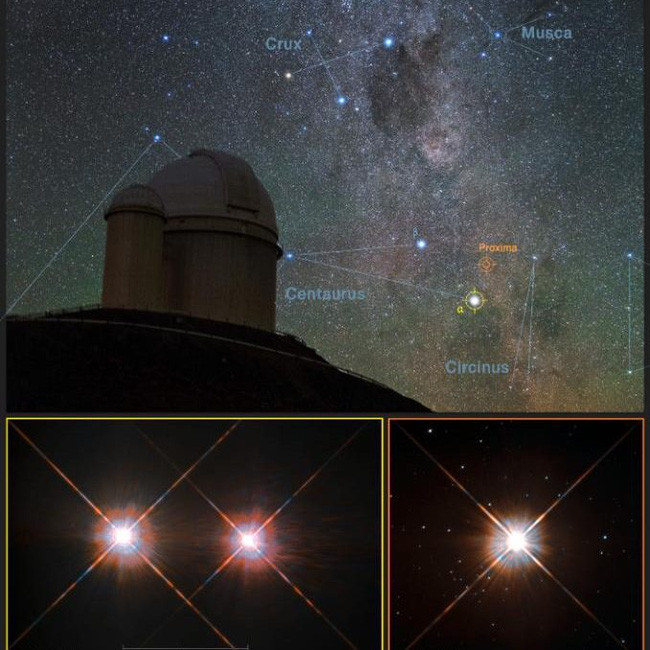How important is the discovery of the Second Earth?
ESO officially confirmed that there is an extremely "2nd Earth" close to our Earth.
According to ESO's announcement, the experts found extremely clear evidence of a planet rotating around Proxima Centauri. Planet named: Proxima b.
Finding Proxima b, Earth-like planet orbiting a star closest to the Sun, could be an important milestone in astronomers' search for space.
Proxima b revolves around its star in a period of 11 days, and with a "standard" distance to have a very balanced temperature, enough to maintain liquid water on the surface.
This planet has a mass only slightly larger than Earth, and is the most exoplanet (planetary solar system) close to us. This may even be the only planet capable of sustaining life that is so close to Earth.

Proxima Centauri is the closest star to the solar system, only 4.2 light-years away.
According to ESO, Proxima Centauri is the closest star to the solar system, only 4.2 light years away. The body is located in the constellation Sagittarius, and as a dwarf, it emits quite weak light.
Moreover Proxima Centauri is located near a larger star Alpha Centauri AB , so it is almost impossible to see with the naked eye.
In the first half of 2016, experts at ESO were actively studying Proxima Centauri based on telescopes located in La Silla (Chile). This star is part of the Pale Red Dot campaign, initiated by astronomer Guillem Anglada-Escudé of Queen Mary University (England).
The objective of the campaign is to determine the strange movement of light around the body, which is caused by gravity from a planet orbiting it.

Red dwarfs like Proxima Centauri, which have a rather active nature.
Red dwarfs like Proxima Centauri, which have a rather active nature, can replicate the presence of a planet, though in fact they are not. Therefore, in order not to . be fooled, the team watched the star's brightness change very carefully.
Data from the Pale Red Dot campaign combined with data provided by ESO observatories have finally yielded an amazing result.
They found that there is a planet with a mass of at least 1.3 times the Earth, orbit about 7 million km from Saturn - just 5% of the distance from the Earth to the Sun.

The graphic compares with the planets' orbits around Proxima Centauri (Proxima b) with other regions in the solar system.
The distance from Proxima b to Venus is even smaller than the distance from Mercury to the Sun. But because Proxima Centauri had a much dimmer brightness, Proxima b was still in the Goldilock region - the life-sustaining distance.
However, the planet's surface can be strongly influenced by ultraviolet rays , far more powerful than what the Earth is experiencing today.
The more descriptive texts on this planet will be published in Nature on August 25, 2016.
- The Kepler spacecraft has just one of the most important discoveries in its history
- Infants have an important position in the Stone Age
- Discovery returned to Earth safely
- Dead Sea scrolls and important archaeological findings in 2017
- New discovery about drug addiction
- Video: Interesting things about the Earth
- Discovery ship leaves the space station
- Coming to the press conference announcing the discovery of the
- Discovery astronauts complete the second walk out of space
- Discovery of carbon and life in the heart of the Earth
- Mexico discovered many important archaeological sites
- Garbage blocking the way of the spacecraft
 Vietnam 5th Asian champion on fuel-efficient vehicles
Vietnam 5th Asian champion on fuel-efficient vehicles We can read all NASA studies completely free of charge
We can read all NASA studies completely free of charge Singer and songwriter Bob Dylan won the 2016 Nobel Prize for Literature
Singer and songwriter Bob Dylan won the 2016 Nobel Prize for Literature Scientific revolution in Asia
Scientific revolution in Asia The discovery of 'Other Earth' may have water, life and right next to us
The discovery of 'Other Earth' may have water, life and right next to us  Super-Earth discovered very close to the solar system
Super-Earth discovered very close to the solar system  Scientists confirm that the
Scientists confirm that the  Discover many interesting things in the star closest to the solar system
Discover many interesting things in the star closest to the solar system  Stephen Hawking: People will live on another planet for the next 100 years
Stephen Hawking: People will live on another planet for the next 100 years  NASA claims Proxima b Earth-like planet b does not support life
NASA claims Proxima b Earth-like planet b does not support life 